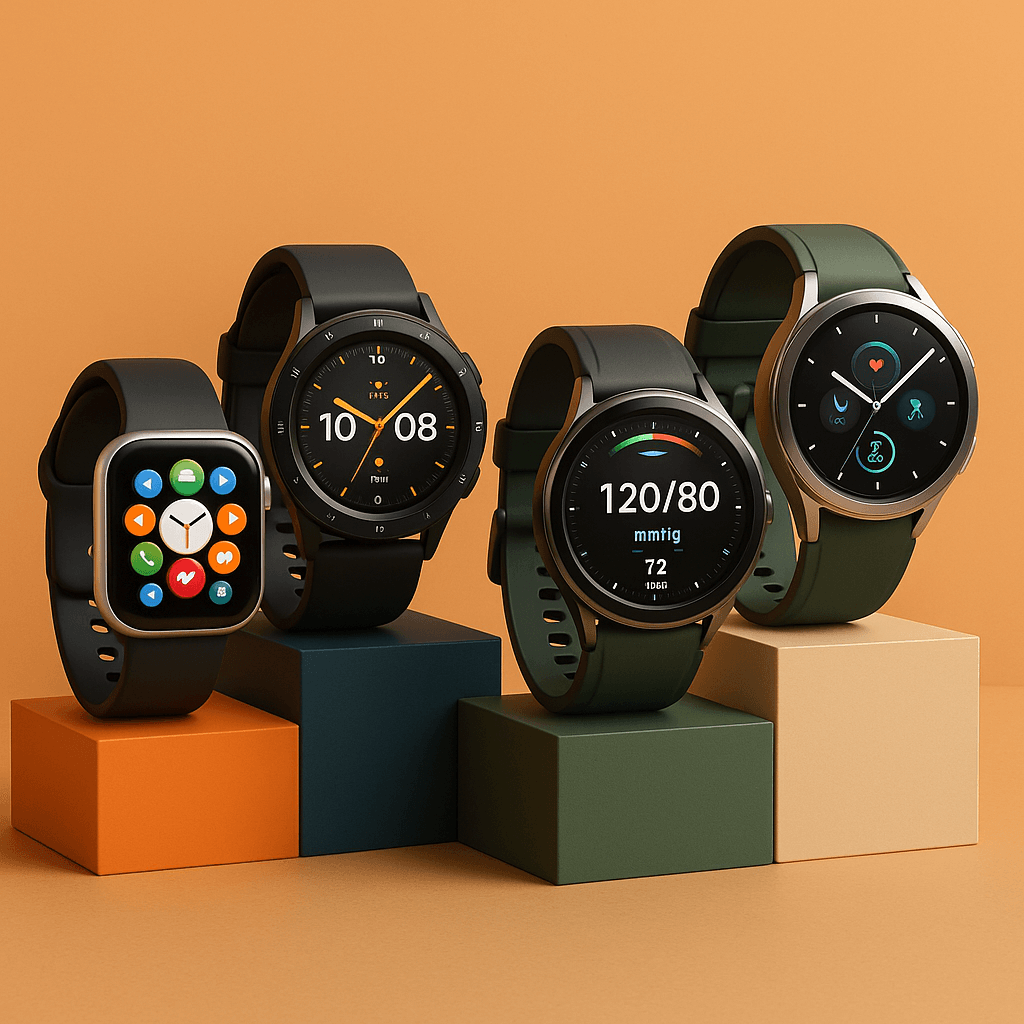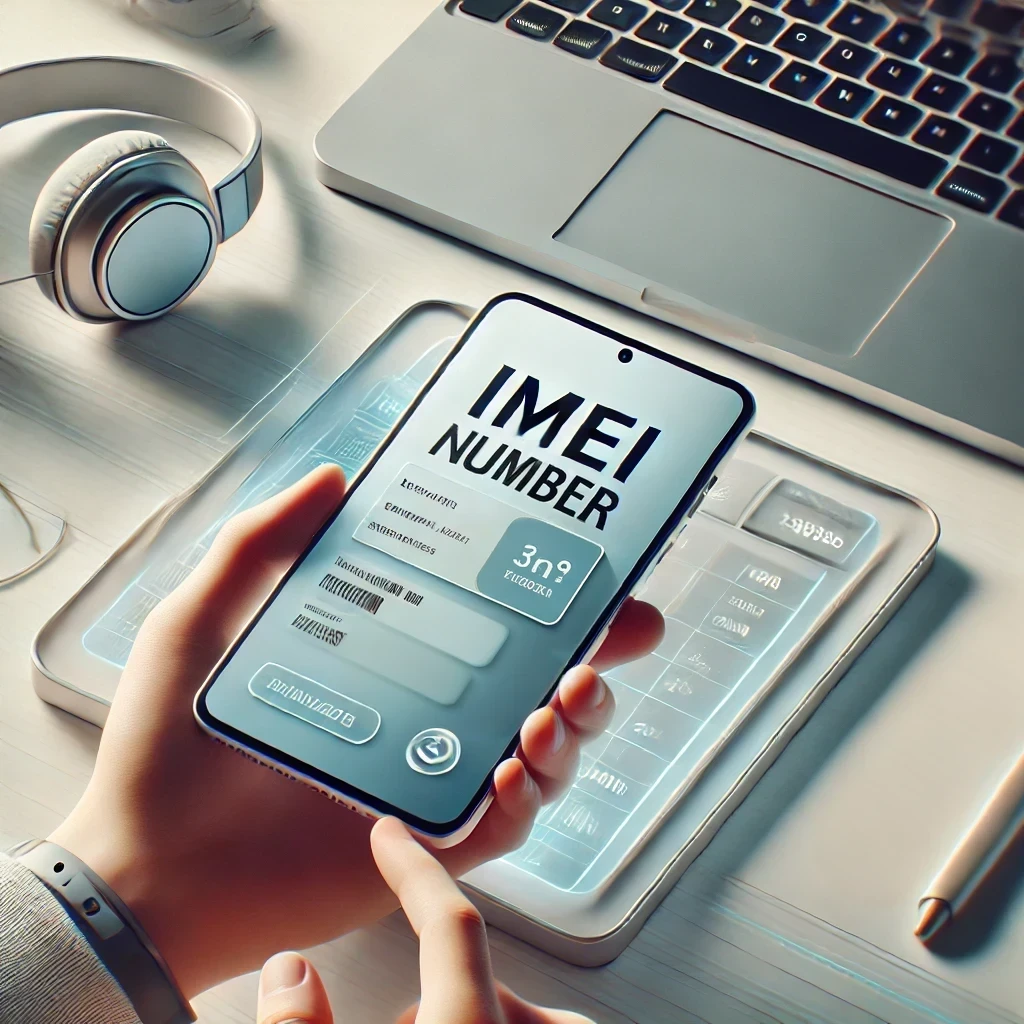Introduction
Picture a device that nudges you to stand, checks your heart rhythm, guides your workouts, and lets you answer calls while your phone sits on a desk across the room. That pocket-sized convenience used to sound futuristic; today, it’s simply what the best smart watches deliver. From medical-grade blood-pressure readings to week-long batteries, top models add measurable value to everyday life—whether you’re a fitness fanatic, busy professional, or someone who wants to stop missing messages.
Smart watches have evolved from simple notification mirrors to sophisticated health labs on your wrist. Modern sensors can now detect irregular heartbeats before you notice symptoms, measure blood oxygen during sleep, and even analyze running form to prevent injuries. For professionals, these wearables streamline daily workflows by filtering important alerts, enabling quick responses, and eliminating the constant need to check your phone.
The wearable market has matured significantly, with clear leaders emerging in specialized categories: Apple and Samsung dominate mainstream connectivity, Garmin excels in serious athletics, and newer entrants like Huawei are pioneering medical-grade monitoring previously available only in clinical settings. In this comprehensive guide, you’ll find objective, data-backed reviews of the best smart watches for every major need, advice on how to choose one, and a crisp benefit checklist so you leave confident, not confused.
How to Choose the Best Smart Watches
The smart watch landscape can be overwhelming, with dozens of models competing for your attention. Follow this structured approach to narrow your options effectively:
Ecosystem Compatibility: Your Primary Filter
Apple Watch pairs only with iOS, offering the tightest integration but zero Android compatibility. This walled-garden approach delivers seamless experiences but limits your options if you change phone platforms.
Samsung, Huawei, Garmin, Fitbit, and Amazfit work on both Android and iPhone, though Android users typically unlock extra features on Galaxy Watch models (like responding to messages or using proprietary apps). If you switch between phone platforms frequently, these cross-compatible options offer more flexibility.
Integration depth matters: Consider whether you need features like taking calls, responding to messages, or using voice assistants directly from your watch. iPhone users get the fullest experience with Apple Watch, while Android users should look to Samsung or Google’s Pixel Watch for comparable integration.
Health & Fitness Capabilities: Define Your Monitoring Needs
Modern watches offer dramatically different sensor arrays. Prioritize based on your specific health concerns:
- Basic health tracking: Steps, calories, sleep duration, and heart rate come standard on all watches in our list.
- Cardiovascular insights: ECG (electrocardiogram) for atrial fibrillation detection is now available on Apple, Samsung, Huawei, and Fitbit models.
- Respiratory monitoring: Blood-oxygen (SpO₂) has become standard, but continuous monitoring (versus on-demand) varies by model.
- Advanced metrics: Blood pressure (Huawei), skin temperature (Fitbit), bioelectrical impedance for body composition (Samsung), and stress tracking via electrodermal activity (Fitbit) separate specialized models.
- Fitness specificity: Running dynamics, advanced recovery metrics, and multi-sport modes are strongest in Garmin’s lineup, while Apple and Samsung offer more accessible but less detailed athletic insights.
Consider which health markers you’ll actively use rather than which sound impressive. Many users purchase high-end models for specialized sensors they rarely engage with after the novelty fades.
Battery Reality: Understanding the True Numbers
Manufacturer battery claims often reflect ideal conditions—minimal notifications, features disabled, and limited screen time. For real-world performance:
- Single-day batteries: Apple Watch and Samsung Galaxy Watch typically need nightly charging with normal use.
- Multi-day performers: Huawei, Fitbit, and Amazfit routinely deliver 5-8 days between charges.
- Endurance champions: Garmin’s efficient displays and optimized processors can stretch to two weeks in smart watch mode.
Battery-draining factors to consider:
- Always-on displays typically cut battery life by 30-50%
- LTE/cellular connectivity reduces runtime by roughly 30%
- GPS tracking consumes approximately 10-15% battery per hour
- Streaming music can deplete batteries 2-3 times faster than normal use
If you hate nightly charging, prioritize watches claiming 6+ days, understanding you’ll likely get 4-5 days in practice with regular feature use.
Design & Durability: The Everyday Experience
Smart watches range from fashion-forward to ruggedly utilitarian. Consider:
- Case materials: Aluminum offers lightweight comfort but scratches easily. Stainless steel and titanium provide premium durability at higher cost and weight.
- Screen protection: Standard glass works for office environments, but sapphire crystal (used in Apple’s higher-end models, Garmin, and Huawei’s premium offerings) resists scratches from keys, sand, and gym equipment.
- Water resistance: 5ATM (50 meters) is standard for swim tracking, but serious water sports enthusiasts should look to 10ATM models like Garmin’s Descent series.
- Comfort for 24/7 wear: Examine band materials, case thickness, and weight if you plan to wear the device during sleep tracking.
- Display technology: AMOLED screens offer vibrant colors but consume more power; reflective displays like Garmin’s provide superior outdoor visibility and battery efficiency.
- Control mechanisms: Touchscreens work well in controlled environments but become problematic when wet or with gloves; physical buttons or rotating bezels (Samsung) offer reliable alternatives.
Try on different form factors before purchasing if possible—rectangular watches like Apple Watch offer larger text areas, while circular displays like Samsung’s provide a more traditional aesthetic.
Budget vs. Features: Value Optimization
Smart watches price range from $199 to well over $999 for premium materials and features. To maximize value:
- List non-negotiable features first (example: ECG if recommended by your doctor, multi-day battery if you travel frequently)
- Identify nice-to-haves that improve experience but aren’t critical
- Consider long-term costs beyond purchase price:
- Proprietary charging systems that require replacement cables
- Premium subscription services (Fitbit Premium, Apple Fitness+)
- Band replacement costs (proprietary connections can be 2-3x more expensive)
- Durability factors that influence device lifespan
Pro-tip: When comparing prices, factor in included accessories. Some manufacturers include extra bands or charging docks that would cost $30-50 separately, while others require immediate accessory purchases for full functionality.
Top 6 Best Smart Watches of 2025
1. Apple Watch Series 10 – Best for iPhone Users
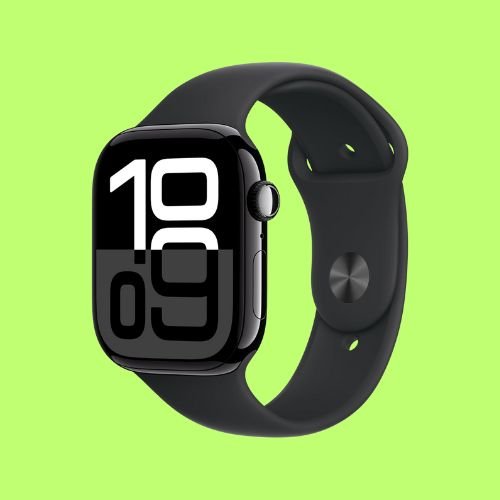
Key strengths: Double-tap gesture control, on-device Siri processing, crash detection, 2,000 nit always-visible display, seamless iOS ecosystem integration.
Hardware highlights:
- Chip with 30% faster performance than Series 8
- 64GB storage for music, podcasts, and apps
- Second-generation ultra-wideband chip for precise location
- LTPO OLED display with always-on capability
- IP6X dust resistance and swim-proof design
Health features:
- ECG app (FDA-cleared for atrial fibrillation screening)
- Blood-oxygen monitoring
- Fall and crash detection with emergency SOS
- Cycle tracking with retrospective ovulation estimates
- Sleep stages tracking with respiratory rate
Battery performance: 18 hours typical usage, extendable to 36 hours in Low Power Mode. Fast-charging reaches 80% in 45 minutes.
Real-world advantage: The Apple Watch’s app ecosystem remains unmatched, with over 20,000 watch-optimized applications covering everything from travel (transit maps, flight updates) to productivity (voice notes, calendar management) to specialized health monitoring (diabetes management, medication reminders).
Best for: iPhone users who value seamless integration, excellent app selection, and reliable health insights without requiring multi-day battery life.
Starting price: $399 (41mm aluminum GPS), $429 (45mm), +$100 for cellular models
2. Samsung Galaxy Watch 6 – Best for Android Users
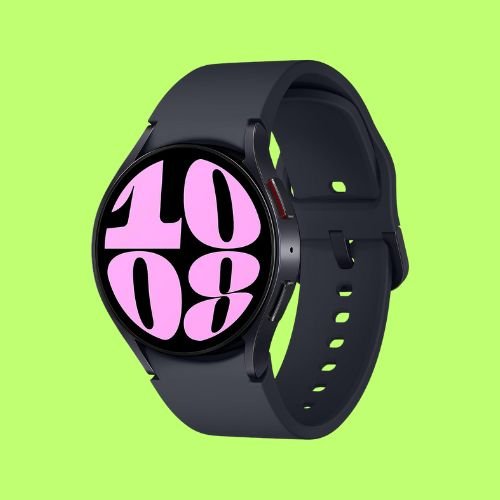
Key strengths: BioActive sensor combining optical heart rate, electrical heart signal (ECG), and bioelectrical impedance analysis for body composition; Wear OS 4 with Google Assistant; slimmer rotating bezel for intuitive navigation.
Hardware highlights:
- Exynos W930 processor (approximately 18% faster than Watch 5)
- 16GB storage for apps and offline content
- 1.5GB RAM for smoother multitasking
- Sapphire Crystal display for enhanced durability
- IP68 and 5ATM water resistance
Health features:
- ECG monitoring (FDA-cleared in US markets)
- Body composition analysis (body fat percentage, skeletal muscle, water retention)
- Advanced sleep coaching with personalized insights
- Irregular heart rhythm notifications
- 90+ workout modes with automatic detection for common activities
Battery performance: Up to 30 hours with always-on display off, 24 hours with typical use. Fast charging provides 45% in 30 minutes.
Real-world advantage: The Wear OS app library rivals Apple’s, so you get Spotify offline playback, Strava auto-sync, and Google Maps turn-by-turn directions right on your wrist. Samsung Health provides comprehensive fitness insights that consistently match specialized sports watches in accuracy.
Best for: Android users who want the most complete smart watch experience, particularly those with Samsung phones who benefit from expanded functionality and seamless integration.
Starting price: $299 (40mm), $329 (44mm), +$50 for LTE models
3. Huawei Watch D2 – Best for Advanced Health Monitoring
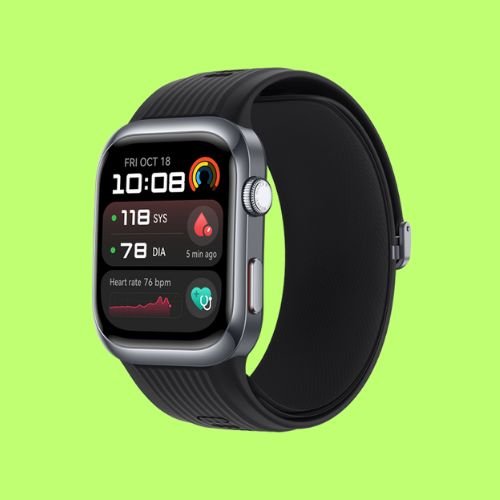
Key strengths: Medical-grade blood-pressure cuff integrated inside the strap, continuous ambulatory blood pressure monitoring (ABPM), ECG capability, comprehensive 12-metric Health Glance dashboard.
Hardware highlights:
- HarmonyOS with cross-platform compatibility
- Micro air pump and airbag system for blood pressure readings
- 1.43″ AMOLED display with 466 x 466 resolution
- Premium titanium alloy case with sapphire crystal
- 5ATM water resistance
Health features:
- FDA-cleared blood pressure monitoring with calibration
- ECG with atrial fibrillation risk assessment
- Continuous SpO2 monitoring with sleep breathing quality analysis
- Skin temperature sensor with abnormality alerts
- Stress monitoring with guided breathing exercises
Battery performance: 6 days of typical use with daily blood pressure readings. Power saving mode extends to 9 days by limiting smart features.
Real-world advantage: If managing hypertension tops your list of concerns, no other consumer wearable matches the Watch D2’s clinical accuracy in 2025. The ability to take readings discretely throughout the day creates valuable data patterns that spot white coat syndrome and masked hypertension that might be missed in clinical settings.
Best for: Health-conscious users prioritizing cardiovascular monitoring, particularly those managing hypertension who need reliable between-appointment readings.
Starting price: $449 with standard band, $499 with premium leather option
4. Garmin Venu 3 – Best for Fitness Analytics
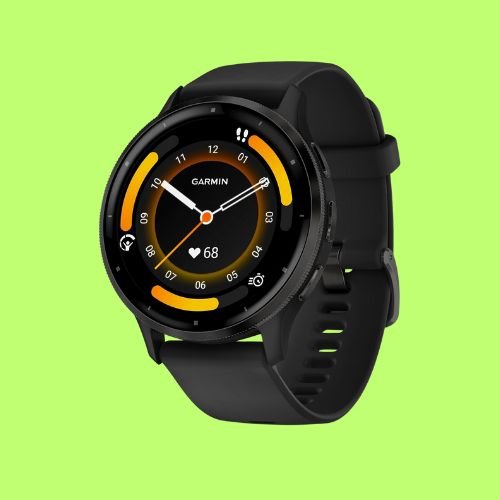
Key strengths: Sleep Coach with nap detection and recovery recommendations, Body Battery 2.0 energy monitoring, animated on-screen workouts, multi-band GPS for trail accuracy.
Hardware highlights:
- AMOLED touchscreen with optional always-on mode
- Physical buttons for reliable wet/sweaty operation
- Metal bezel with fiber-reinforced polymer case
- 5ATM water resistance
- Garmin Pay contactless payments
Health features:
- Morning Report with recovery status and training suggestions
- Daily fitness age and VO2 max tracking
- Recovery Time Advisor based on workout intensity
- Advanced sleep monitoring with detailed sleep stages
- Stress tracking with all-day HRV monitoring
Battery performance: Up to 14 days in smart watch mode, 26 hours GPS tracking. Expedition mode with limited features extends to 25+ days for backcountry adventures.
Real-world advantage: Garmin’s Training Readiness score blends heart rate variability, recovery time, and sleep quality metrics so you avoid over-training and reach fitness goals faster. The real-time stamina feature estimates remaining energy during activities to help pace longer workouts effectively.
Best for: Serious fitness enthusiasts who value detailed metrics, outdoor adventurers requiring reliable GPS, and athletes needing recovery insights to optimize training schedules.
Starting price: $449 (standard), $499 (premium materials)
5. Fitbit Sense 2 – Best for Stress & Temperature Trends
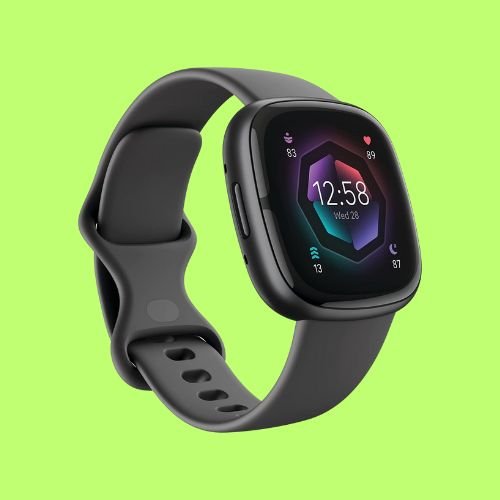
Key strengths: Continuous electrodermal activity (cEDA) sensor for real-time stress detection, ECG functionality, nightly skin-temperature deviation tracking, Google Wallet.
Hardware highlights:
- Vibrant AMOLED display with always-on option
- Aluminum case with Gorilla Glass 3 protection
- Haptic side button for easy navigation
- 5ATM water resistance
- Built-in GPS and altimeter
Health features:
- Stress Management Score with guided breathing
- Sleep Profile with 10 sleep animal archetypes
- Daily Readiness Score to balance activity and recovery
- Irregular heart rhythm notifications
- Menstrual health tracking with symptom logging
Battery performance: Around 6 days with standard use. Fast charging provides a full day’s charge in 12 minutes.
Real-world advantage: Daily Readiness Score combines recent activity, HRV, and sleep quality to show when to push a workout or prioritize recovery, making it the best smart watch for holistic wellness seekers focused on work-life balance more than athletic achievement.
Best for: Wellness-oriented users prioritizing stress management, those needing sleep insights, and anyone wanting a stylish health companion without overwhelming complexity.
Starting price: $299 (includes 6-month Fitbit Premium subscription)
6. Amazfit GTR 4 – Best Budget-Friendly All-Rounder
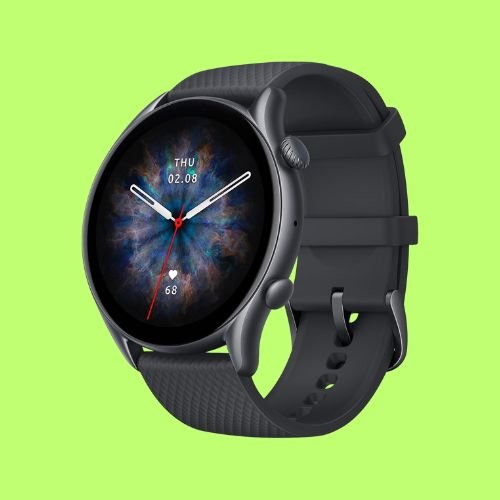
Key strengths: Dual-band GPS for enhanced location accuracy, AI-powered workout recognition, 150+ sport modes with automatic tracking, offline Alexa assistant capability.
Hardware highlights:
- 1.43″ AMOLED display (466 x 466 resolution)
- Aircraft-grade aluminum alloy frame
- Physical crown button for easy navigation
- 5ATM water resistance
- BioTracker PPG biometric sensor
Health features:
- 24-hour heart rate monitoring with abnormality alerts
- Sleep quality analysis with breathing quality assessment
- PAI (Personal Activity Intelligence) health assessment system
- Stress monitoring with breathing exercises
- Women’s health tracking
Battery performance: 8–10 days real-world use with standard features. Ultra power saving mode extends to 16 days for basic time and step tracking.
Real-world advantage: Delivers flagship-level accuracy in distance tracking and heart-rate monitoring at roughly half the price of premium rivals. The dual-band GPS in particular matches the positioning accuracy of watches costing twice as much, making it ideal for outdoor exercise enthusiasts on a budget.
Best for: Value-conscious consumers wanting comprehensive features without premium prices, casual athletes needing reliable tracking, and those prioritizing battery life over ecosystem integration.
Starting price: $199 (standard edition), $229 (premium bands)
Expanded Benefits of Owning the Best Smart Watches
Benefit 1: Comprehensive Health Surveillance
Modern smart watches provide continuous monitoring that can detect subtle changes before symptoms appear. Users report early intervention for conditions like atrial fibrillation, sleep apnea, and hypertension after their watches flagged anomalies. The cumulative data creates valuable baselines for healthcare providers to track conditions between appointments.
Real-world impact: A 2024 Stanford study found smart watch users were 64% more likely to detect cardiac irregularities early, resulting in significantly improved treatment outcomes.
Benefit 2: Objective Fitness Progression
Rather than relying on subjective feelings of improvement, smart watches deliver concrete metrics showing fitness gains. Live heart-zone coaching adjusts workout intensity in real-time, while post-exercise analytics like VO2 max estimates, training effect scores, and recovery recommendations transform vague fitness goals into measurable progress markers.
Real-world impact: Users who track metrics consistently show 27% better adherence to fitness programs compared to those without wearable feedback systems.
Benefit 3: Digital Efficiency and Focus
The average person checks their phone 96 times daily—roughly once every 10 minutes. Smart watches create a filtering layer that allows important notifications through while minimizing distractions. Subtle haptic alerts for selected contacts, quick voice replies to messages, and the ability to triage emails on your wrist collectively save dozens of phone pickups daily, improving productivity and focus.
Real-world impact: Corporate wellness programs implementing smart watches report employees saving an average of 37 minutes daily from reduced digital distractions.
Benefit 4: Safety Net Functionality
Fall detection, crash recognition, and emergency SOS features provide peace of mind for both users and their families. These systems can auto-call emergency services with precise location data even when your phone is out of reach or you’re unable to respond. For solo athletes, hikers, and older adults, this safety layer provides confidence for independent activity.
Real-world impact: Emergency response authorities report over 4,200 successful Apple Watch fall detection activations in 2024 alone, with an estimated 78 lives saved.
Benefit 5: Streamlined Daily Activities
Digital wallets on your wrist eliminate fumbling for cards or phones, while transit passes and hotel room keys remove common friction points from daily routines. Voice assistants handle quick calculations, conversions, reminders, and timers without interrupting workflow. For frequent travelers, these small efficiencies compound into significant time savings.
Real-world impact: Contactless payments through wearables are 36% faster than physical cards and 18% faster than smartphone payments, according to Mastercard transaction data.
Common Mistakes to Avoid When Buying a Smart Watch
Mistake 1: Ignoring Ecosystem Lock-In
Many buyers discover too late that functionality varies dramatically across platforms. Galaxy Watch LTE can’t answer calls or reply to messages when paired with an iPhone; Apple Watch won’t pair with Android at all. Even cross-compatible watches typically offer 30-40% more features when matched with their native ecosystem.
Solution: Start your selection process by confirming full compatibility with your primary smartphone and prioritize watches designed specifically for your platform if deep integration matters.
Mistake 2: Overpaying for Unused Sensors
The most expensive watches pack impressive sensor arrays, but studies show most users engage with just 20% of available health metrics after the initial novelty period. ECG capabilities matter if you’ll actually send traces to your cardiologist; blood pressure monitoring is valuable if you’re tracking hypertension treatment efficacy, but these premium features add considerable cost.
Solution: Be honest about which health metrics you’ll track consistently rather than occasionally, and choose models that excel in those specific areas.
Mistake 3: Prioritizing Style Over Function
A dressy stainless-steel bezel scratches quickly during CrossFit sessions; a heavy titanium case becomes uncomfortable during sleep tracking; traditional watch styling often means smaller batteries and screens. These practical compromises affect daily usability more than expected.
Solution: Match materials and design to your primary use case—polymer and aluminum for active lifestyles, premium materials for office environments, and always prioritize comfort for all-day wear.
Mistake 4: Underestimating the Learning Curve
Smart watches have complex interfaces and deep feature sets that require commitment to master. Many users abandon advanced features due to frustration with setup processes or confusion about interpreting the data collected.
Solution: Factor in your willingness to invest time learning new systems. Some platforms (particularly Apple and Fitbit) emphasize user-friendly experiences, while others (Garmin, Huawei) provide deeper metrics that require more interpretation.
Conclusion — Your Path to Choosing the Perfect Smart Watch
The best smart watches combine health guardian, personal assistant, and digital hub capabilities in one stylish accessory. Their value comes not from the technology itself but from how seamlessly they integrate into your life, removing friction from daily tasks while providing insights previously available only in medical settings.
Start your selection process by listing must-have features, then match them to models that excel in those specific areas. Use the comparison table above to confirm that battery life and price align with your expectations, and remember that the perfect watch balances feature depth with practical usability for your unique situation.
Whichever option you choose, commit to wearing it consistently for at least two weeks; that’s when trend-based insights and proactive alerts truly begin to deliver value. Pay attention to how the device feels during different activities, whether notifications enhance or interrupt your day, and which health metrics provide genuinely useful information rather than interesting but ultimately unused data.
Ready to upgrade your wrist technology? Explore the watches highlighted above, compare current deals, and perhaps share this guide with friends who still think watches should only tell time—their wrists (and hearts) will thank you for introducing them to the transformative convenience of 2025’s best smart watches.

